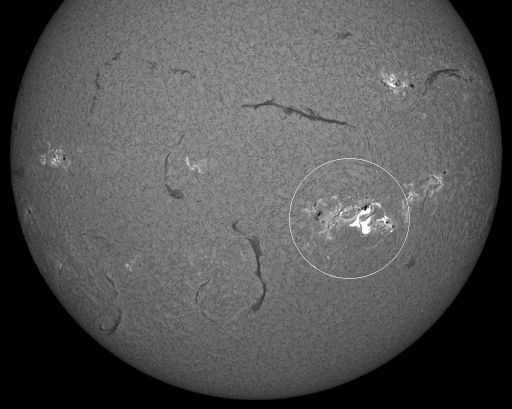 09-28-2014, 08:18 AM
09-28-2014, 08:18 AM
|
#1065
|
|
⊙▃⊙
  
Join Date: Nov 2007
Location: I live in the last place where you Look.
Age: 31
Posts: 7,376
|
 Re: Terry's Astronomy Thread.
Re: Terry's Astronomy Thread.
Daily Suspicious0bserver's Weather Post:
September 28, 2014
What's in the sky tonight?
September 28, 2014
-Weekend fireworks were predicted, and the sun complied. On Sunday, Sept. 28th (0258 UT), the magnetic canopy of sunspot AR2173 erupted, producing an M5-class solar flare. The sun was high overhead in Australia when Matt Wastell of Brisbane photographed the explosion. Extreme UV radiation from the flare ionized the top of Earth's atmosphere, disturbing the normal propagation of radio transmissions around our planet. In particular, there was a limited blackout of HF radio communications and a probable loss of shortwave radio contact in daylit areas for some tens of minutes.
At the moment, we do not know if this explosion hurled a coronal mass ejection (CME) toward Earth. Based on the impulsiveness (brevity) of the flare, we think not. A final answer awaits coronagraph data from the SOHO and STEREO spacecraft.
Wastell's picture, which he took using a solar telescope tuned to the red glow of solar hydrogen, shows more than a half-dozen dark magnetic filaments winding across the face of the sun. Like sunspots, these filaments pose a threat for flares. When a magnetic filament collapses it can hit the stellar surface and explode, causing a type of "spotless" explosion called a Hyder flare.
Taking into account all of the sunspots as well as the filaments, NOAA forecasters estimate a 65% chance of M-class flares and a 10% chance of X-flares in the next 24 hours.
 Astro Picture of the Day:
September 28, 2014
Source:
Astro Picture of the Day:
September 28, 2014
Source:
What's happening at the center of active galaxy 3C 75? The two bright sources at the center of this composite x-ray (blue)/ radio (pink) image are co-orbiting supermassive black holes powering the giant radio source 3C 75. Surrounded by multimillion degree x-ray emitting gas, and blasting out jets of relativistic particles the supermassive black holes are separated by 25,000 light-years. At the cores of two merging galaxies in the Abell 400 galaxy cluster they are some 300 million light-years away. Astronomers conclude that these two supermassive black holes are bound together by gravity in a binary system in part because the jets' consistent swept back appearance is most likely due to their common motion as they speed through the hot cluster gas at 1200 kilometers per second. Such spectacular cosmic mergers are thought to be common in crowded galaxy cluster environments in the distant universe. In their final stages the mergers are expected to be intense sources of gravitational waves.
|

|

|